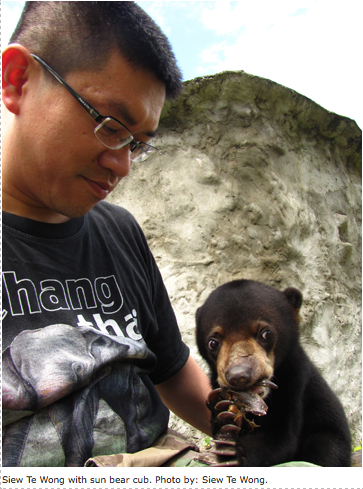The Forgotten Bear
From JeffCorwinConnects.com:
By
May 25, 2011
 Malayan sun bears, also known as honey bears (or Helarctos malayanus), are the least known of the world’s eight bear species. Few people know they even exist, especially compared with other types of bears, like polar bears and grizzlies.
Malayan sun bears, also known as honey bears (or Helarctos malayanus), are the least known of the world’s eight bear species. Few people know they even exist, especially compared with other types of bears, like polar bears and grizzlies.
Perhaps part of that is because sun bears are so challenging to study. They’re the smallest bear species. They weigh just 100 pounds and are less than half the size of a North American black bear.
To complicate matters, they have black fur and spend their time in the trees of Southeast Asia’s dense tropical rainforests-making simply finding them a tricky task. In this case, out of sight has meant out of mind-and little attention has been given to this endangered species.
But one man, Malaysian biologist Siew Te Wong, has dedicated his life to changing the status of what he calls “the forgotten bear.” He’s one of the world’s few sun bear researchers and also founder of the Bornean Sun Bear Conservation Centre (BSBCC) in Sabah, Malaysia.
Wong has successfully overcome many research challenges. Because failure is the mother of all invention, his difficulties forced him to design new equipment and take new approaches to get to know this species. For instance, he devised a new type of trap that he could break down and backpack into the forest.
He’s also experimented with bait to attract the animals so that he could radio collar them for study. While it was never his intent, with much trial and error he eventually became “top chef” to these endearing creatures when he hit on the perfect recipe (that is, chicken guts). The result of his over 15 years of effort: a wealth of data about the biology, habits and range of this elusive bear.
For instance, his study of wild sun bears shows that they are diurnal and not nocturnal, as is commonly assumed. Rather, he notes that sun bears that live close to human typically switch their activities to nighttime to avoid human confrontation.
 He’s also uncovered the bear’s favorite food. Any guesses? According to Wong, it’s beetle larvae! Though he’s never been tempted to try one himself, Wong enjoys watching the bears dig into a decayed piece of wood with such fierce concentration that it may be hours until they finally find their three-inch reward. The moment they fish one out, they pull their facial muscles back in a smile, close their eyes and let their big, fat, juicy “packed-with-protein” prize melt in their mouth. Wong says, “it’s like they’re having the best chocolate in their life!”
He’s also uncovered the bear’s favorite food. Any guesses? According to Wong, it’s beetle larvae! Though he’s never been tempted to try one himself, Wong enjoys watching the bears dig into a decayed piece of wood with such fierce concentration that it may be hours until they finally find their three-inch reward. The moment they fish one out, they pull their facial muscles back in a smile, close their eyes and let their big, fat, juicy “packed-with-protein” prize melt in their mouth. Wong says, “it’s like they’re having the best chocolate in their life!”
Sun bears’ love for invertebrates helps the ecosystem in two critical ways. First, by eating pests like termites that kill or infest trees, sun bears help maintain healthy forests providing an important pest control service. Second, in their hunt for bugs, sun bears will smash termite mounds and crack open tree cavities, which in turn creates new nesting and feeding sites for other species, like flying squirrels. In essence, that makes them “ecosystem engineers.”
Sun bears serve another important ecosystem function: seed dispersers. They often feed on large fruit with sizeable pits, like durian, that are too big for other species. Then, by depositing the pits far from the mother trees, the bears facilitate germination and increase the survival rate of seedlings, thus helping to “plant the forest.”
Despite the sun bears role in helping to maintain their forest home, they face multiple threats, so much so that they are listed under Appendix I of the Convention on International Trade in Endangered Species (CITES), which prohibits their commercial trade. Unsustainable logging and expansion of industrial palm oil plantations are already destroying significant swaths of their tropical habitat. In addition, pet trade and uncontrolled poaching for their parts, which are used in traditional Asian medicine, imperil the species.
Nobody knows how many sun bears remain in the wild. Many scientists say they’re the rarest of the bear species and suggest their numbers have fallen by more than 30 percent in the last 30 years. Wong has tried to estimate sun bear populations but has failed thus far because he hasn’t found a reliable method.
One survey technique used by scientists for species like tigers assesses the capture and recapture rate by remote cameras and extrapolates from there. But this approach won’t work for sun bears because individuals cannot be identified from a camera picture because they’re just black; they don’t have a special marking.
DNA analysis is another way to get at this information, but collection of a sun bear’s genetic material is quite difficult because in a tropical forest it rains every day. Whatever the number, one thing is certain: rapid loss of forests throughout their range and an active trade in wild bears and their parts point to a bleak future. Yet there is much the average citizen can do.
Wong notes that whenever he’s asked how somebody can help, he always answers, “do whatever you do best!” For instance, artists painting pictures of sun bears, which the Bornean Sun Bear Conservation Centre then sells at auctions to raise funds. Reporters report about the bear.
“There are so many people that have heard about polar bears, grizzly bears and giant pandas,” Wong says, “but they’ve never heard about sun bears. By helping to spread the word about sun bears-showing people pictures of them, putting stories about sun bears on Facebook-they help us to promote awareness. Unfortunately, our conservation work spends money and, generally, the amount of money we raise reflects the amount of work we can do to help a species. [But] fundraising for an animal that is not well known is not easy.”
If everybody shared information and stories, we could raise the profile-and ultimately the chances of its long-term survival-of this forgotten bear.
